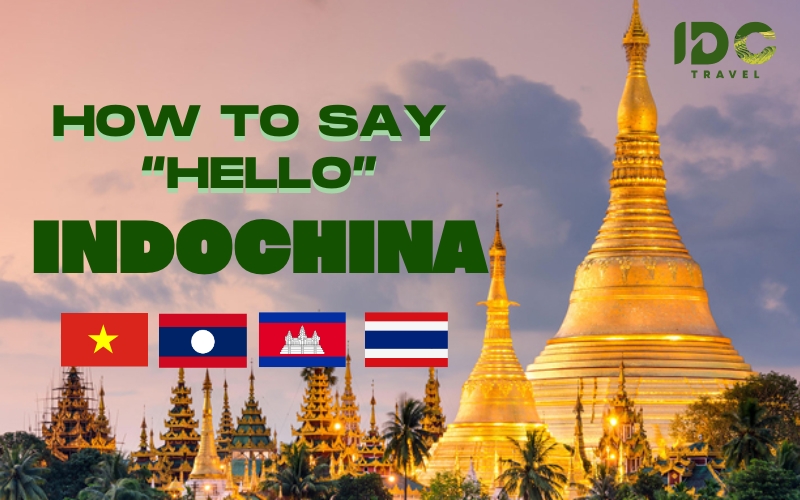
Have you ever felt confused when you arrive in a new country, not knowing how to greet people properly without coming across as awkward or disrespectful? I have – more than once. When I first arrived in Southeast Asia, I quickly realized that greetings are not just formalities – they are a reflection of respect, culture and connection.
In countries like Vietnam, Thailand, Laos and Cambodia, how you greet can shape the entire interaction. Simple gestures like saying “hello” or “thank you” in the local language can go a long way in building rapport and showing respect. Based on my experience (and a few personal mistakes), this Indochina greetings guide will help you greet people across the region with confidence and cultural awareness.
Why Greetings Matter in Indochina?
Before my first trip to Southeast Asia, I didn’t think much about how to greet people. But after spending time in Vietnam, Thailand, Laos and Cambodia, I quickly realized that greetings here are not just about polite words, but also about respect, cultural values and social awareness.
Greeting styles vary widely – and sometimes, even within the same country. And when you travel, especially to Asian countries, the differences become even more pronounced! Forget the usual handshakes and half-hearted hugs, because the art of greeting has been taken to a whole new level in Indochina. Indochina’s cultural diversity brings with it a wealth of interesting customs, especially when it comes to greetings and hospitality. And learning them will not only help you overcome language barriers, but also help you respect local traditions and sometimes save you embarrassment.
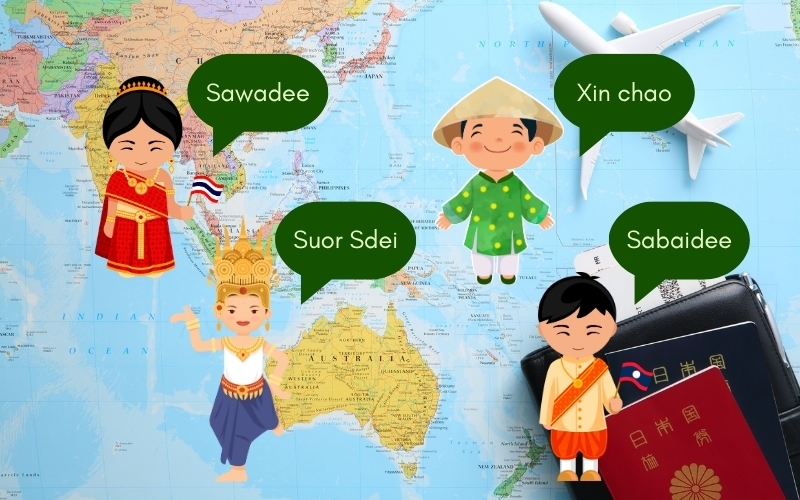
Greeting styles across Indochina
In these predominantly Buddhist countries, greetings are usually gentle, humble, and meaningful. It’s not just the words, but also body language, tone of voice, and knowing when to bow slightly, when to use a hand gesture, or when to simply smile. I made a few silly mistakes at first, like shaking hands with a monk in Chiang Mai, or casually waving and saying “Hello” to an elderly shopkeeper. She just smiled kindly, but I later learned that a simple “Sabaidee” with a slight bow shows much more respect – especially to older people.
What makes me feel better is that locals are very tolerant of tourists who may not be familiar with them, and many will even help you learn some of their basic greetings. A proper, warm greeting can lead to a more intimate conversation, an invitation to a cup of tea from a local.
How to Say Hello in Vietnam
Before I first came to Vietnam, I thought “Xin chao” was enough to say a friendly hello to everyone, and while it was technically fine, I quickly realized that locals don’t use it very often in everyday life. In fact, Vietnamese greetings are much more personal and sophisticated.
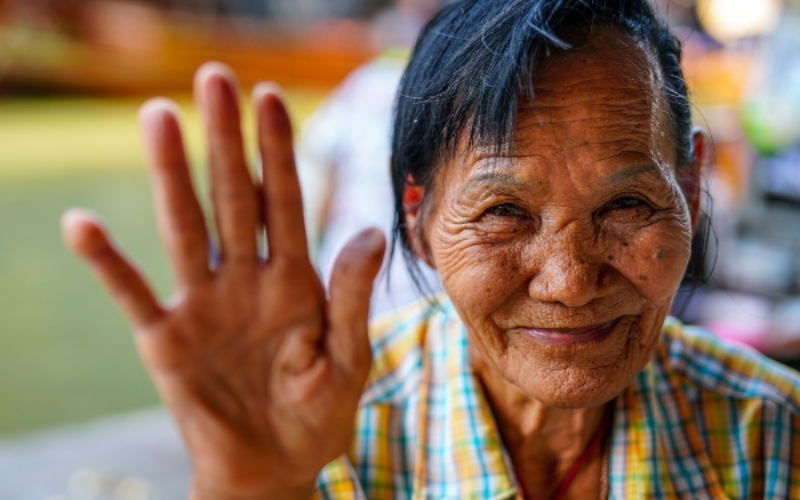
Smiling with a friendly hello in Vietnam
Instead of just “Xin chao” (Sin chow), people often greet each other with “Chao” followed by an appropriate title, depending on the age and gender of the other person. For example:
“Chao anh” (hello brother/younger brother)
“Chao chi” (hello sister/younger sister)
“Chao em” (hello younger person)
“Chao bac” (hello uncle/younger aunt/older person)
You can add the word “ạ” after to show respect, especially to older people. For men, greetings usually include a firm handshake combined with a nod in response. A simple but effective way to show respect, especially when meeting older people, is to shake hands with both hands and bow slightly. Women, on the other hand, often opt for a polite bow combined with a nod. So when meeting Vietnamese women, respond with a friendly nod if they bow instead of shaking hands.
And don’t forget, Vietnamese is a tonal language. That means even small pronunciation mistakes can lead to confusion. However, don’t stress too much about getting it perfect – the locals appreciate your effort, and a smile goes a long way.
Pro tips:
- If you find it too complicated, keep it simple or watch the locals ask each other questions and don’t ask them to teach you a few basic words.
- Not sure what to say? Just stick to “Hello brother” or “Hello sister” depending on whether the person seems older than you. It’s a safe bet!
- Greetings in the three regions of Vietnam, North, Central and South, have slight differences in pronunciation, but the structure remains the same. So don’t worry, you’ll be understood!
> > > Want to practice your Vietnamese greetings in a meaningful way? On our authentic Vietnam Tours, you’ll visit rural villages, join cooking classes, and chat with local families, perfect for saying “Xin chao” with confidence and a smile.
How to Say Hello in Thailand
The first Thai word I learned like most visitors was “Sawadee”, and I must have said it ten times on my first day in Bangkok. In Thai, “sawadee” means “may all things be well with you”. It is a common greeting in Thailand and can be used in almost any situation, from meeting new people, entering a shop to thanking someone politely. What I didn’t know at first, however, is that the way you say it changes slightly depending on your gender. If you want to greet a woman, you say “sawadee kha” (Sah-wah-dee ka), while if you want to greet a man, you say “sawadee khab” (Sah-wah-dee krap).
But saying it is only half the greeting. What is so unique to Thai culture is the “wai” – a graceful gesture that involves clasping your hands together as if in prayer and bowing your head slightly. On my first morning in Chiang Mai, I greeted the hotel receptionist with a quick “Sawasdee ka” and a shy wai that I had practiced in front of the mirror. She smiled warmly and returned the gesture easily, making me feel instantly welcome.
> > > Learn to say “Sawasdee ka/krap” and use the wai gesture like a local on our Authentic Thailand 12 Days Tour, where real cultural experiences go beyond the guidebook.
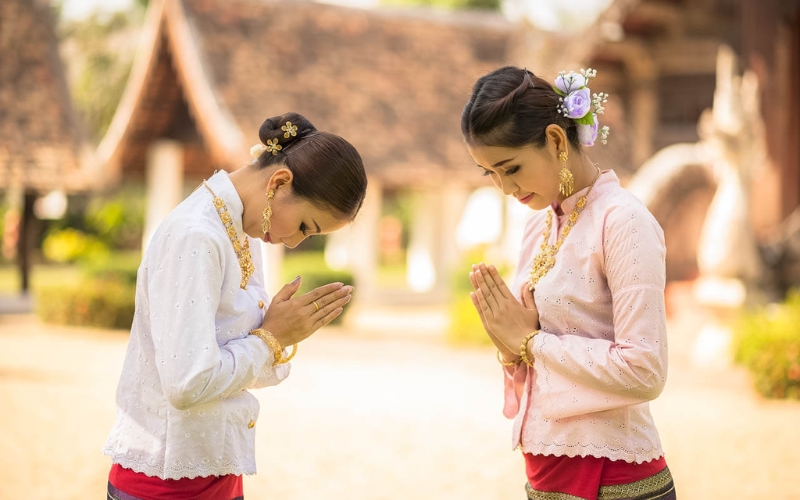
Thai woman greeting with a Wai
Performing a perfect Wai requires finesse. Especially when greeting with your eyes, you should not look directly into the other person’s eyes as this is considered disrespectful or rude to Thais. Another interesting thing is that the height of the wai shows respect. For peers or shopkeepers, you can place your hand at chest level. For elders or anyone of higher social status, bring your hand closer to your face and bow lower. The tip of the hand should be raised just above the eyebrows when bowing to Buddha or royalty.
When I visited a temple in Ayutthaya, my guide gently reminded me to bow a little lower when greeting monks. Little gestures like this mean a lot in Thai culture.
Pro tips:
- Practice the wai in front of a mirror before you go. It sounds silly, but I did it on my first night in Bangkok and it saved me a few awkward moments the next day. It will become second nature after you do it a few times.
- If someone greets you first, return the gesture – unless they are younger or in a service job (like hotel staff), then a polite smile or nod will suffice.
- In temples or when meeting older people, use the full greeting by politely saying “Sawasdee kráp/ka”. But in more casual settings like markets or cafes, a warm “Sawasdee” and a smile will suffice.
How to Say Hello in Laos
Laos is one of the most peaceful and welcoming countries I have ever visited, and greeting properly shows respect. The most common greeting you will hear and should use is “Sabaidee” (Sa-bai-dee). It is friendly, simple and suitable for most situations, whether you are meeting a hotel owner, chatting with a street vendor or just walking around the village.
But what really makes greetings special in Laos is the “nop” gesture, which is similar to the Thai “wai” but has its own nuances. You will place your hands together at chest level in a prayer position, the position of the fingertips can change depending on the gender and age of the person you are greeting. For elders or monks, raise your hands higher (closer to your face) and bow slightly lower. When greeting people your age or younger, a simple “sabaidee” accompanied by a slight nod is perfectly fine. It is important to note that you should never raise your hand above your nose.
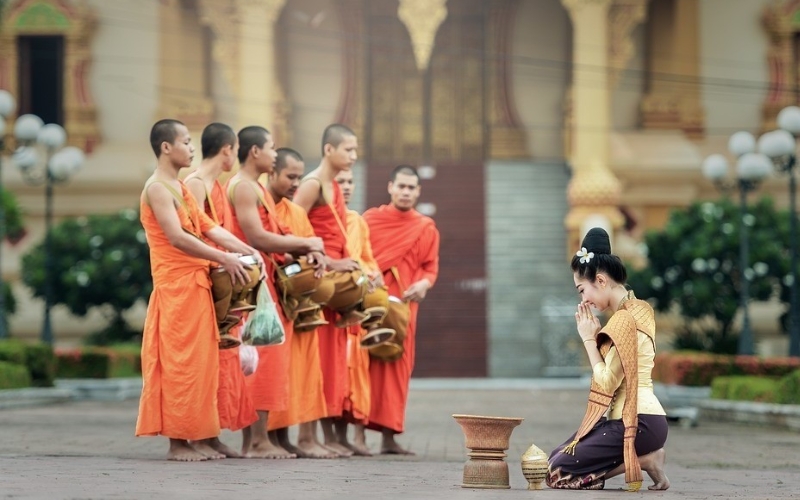
Traditional Lao greeting during morning alms
One thing I have noticed in smaller villages is that people are especially touched when foreigners make an effort to greet them respectfully. I remember the first time I greeted an old man in Luang Prabang this way, his face lit up, and he responded with such warmth that it instantly broke down any cultural barriers.
Pro tips:
- Even if you are shy, try using “nop”. It may seem a little formal at first, but locals really appreciate the effort.
- Before you say anything, smile. In Laos, a warm smile is part of the greeting. It shows goodwill, especially if your Lao pronunciation is not perfect (which is completely normal).
- Laos do not usually shake hands, especially in rural areas. If someone offers you a handshake, you can accept it, but never shake hands with a monk or an elderly person.
> > > Want to practice local greetings across three countries? Our Heritages of Vietnam, Laos & Thailand Tour lets you experience real cultural connections in just 15 days. It’s culture, connection, and unforgettable moments, all in one epic trip.
How to Say Hello in Cambodia
When I first arrived in Cambodia, I was greeted with warm smiles and warm hospitality everywhere, but I quickly realized that the way people greet each other has a deep cultural meaning. When you greet them in Khmer, their native language, you feel like you are meeting an old friend, not a tourist. In Khmer, there are two common ways to greet.
Formal: Chom Reap Sour
This greeting (Choom-ree-up-soo-er) is appropriate when greeting elders or individuals on more formal occasions. This formal greeting shows the utmost respect and is perfect for visitors who want to make a good first impression in Cambodia. It is often combined with a gesture called sampeah – where you clasp your hands together as if in prayer and bow slightly. It reminds me of the Thai “wai” or the Lao “nop”, but in Cambodia, the height of the hand is more important.
Here are five levels of Sampeah etiquette, depending on who you are greeting:
- First level of Sampeah: For friends and colleagues, bring your hands and palms together at chest level.
- Second level of Sampeah: For your boss, elders, or people of higher status, bring your hands and palms together at mouth level.
- Third level of Sampeah: For parents, grandparents, or teachers, bring your hands and palms together at nose level.
- Fourth level of Sampeah: For kings or monks, bring your hands and palms together at eyebrow level.
- Fifth level of Sampeah: When praying to God or sacred statues, bring your hands and palms together at forehead level.

Tourists learning how to greet in Cambodia
Informal: Susadei
In informal, everyday situations, locals often just say “Suor Sdei,” (Soo-er sdai) which is a more informal way of speaking to friends. I often use this phrase when chatting with vendors at the Old Market or when checking into a hotel. This simple greeting makes the conversation friendly and comfortable.
Pro tips:
- Don’t sampeah younger people or staff: I made this mistake early on – shaking hands with hotel staff when they greeted me. But in fact, staff and people younger than you should shake hands first, and you can nod or smile in return. Overuse of this word can come off as awkward or too formal.
- In rural areas, greetings are often made with both hands and sometimes food: During a homestay in Takeo Province, I was greeted by a local who handed me sticky rice and clasped his hands together. This combination of food and formality is very common in rural hospitality culture. If you are offered something, accept it with both hands and bow slightly.
> > > From saying “Chum Reap Suor” in quiet villages to exploring ancient temples, our Panorama of Cambodia in 13 Days tour is the perfect way to experience the country up close and authentically. It is a journey full of culture, connection, and unforgettable moments.
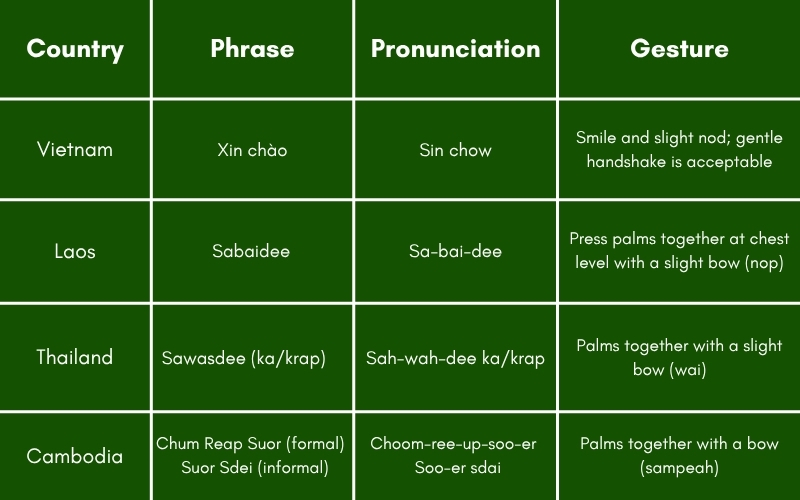
Summary of Common Greetings and Cultural Gestures in Indochina
Some Practical Tips for Travelers
After spending time in all four Indochina countries – Vietnam, Thailand, Laos and Cambodia – I’ve had my fair share of awkward greetings, funny misunderstandings and warm, sincere exchanges. Here are some tips I’ve learned – things I wish I’d known before my first trip:
- Be mindful of who you’re greeting (age and status): especially in Vietnam and Cambodia, how you greet depends a lot on who you’re talking to. I once greeted my tour guide with a very enthusiastic “Chào anh ạ” and he smiled shyly. I suddenly realised I’d made a mistake, “anh” is for an older male, but he was much younger than me and that made him feel very shy.
- Use both hands when handing something over – especially when greeting: When giving a gift, handing over money, or even just exchanging something like a business card, use both hands to show respect, especially in formal settings.
- Let the locals initiate physical contact: You may find a handshake as a greeting very common, but in Indochina, especially with women or older people, physical contact is not always appropriate. If they initiate a handshake, shake back cheerfully.
- Tone is more important than pronunciation: Don’t worry if your accent isn’t perfect. Polite tone and modest effort are more important than perfect grammar. Locals are understanding and respond in kind, some even taught me how to improve my pronunciation.
- See how the locals do it: This has helped me many times. When I don’t know how to greet someone (especially an elder or a monk), I just stop and observe. Follow their lead, it shows respect and ensures you don’t accidentally offend anyone.
What a fascinating language journey, right? Indochina’s cultural diversity brings with it a wealth of interesting customs, especially when it comes to greetings and hospitality. No one said it was easy, but no one said it wasn’t fun! Learning these customs will not only help you overcome language barriers, but it will also help you show respect and openness, which will lead to the most meaningful connections on your journey. If you’re planning a trip to Vietnam, Thailand, Laos or Cambodia and want a deeper and more authentic cultural experience, contact us today and don’t worry, we’ll help you greet like a local from day one!
Read more:
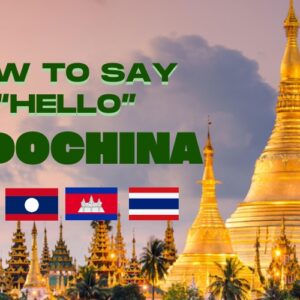



I would to travel in Vietnam in November. Please let me know your package.
Thank you for your interest. Our sales department will contact you via email to send you tour packages in Vietnam.